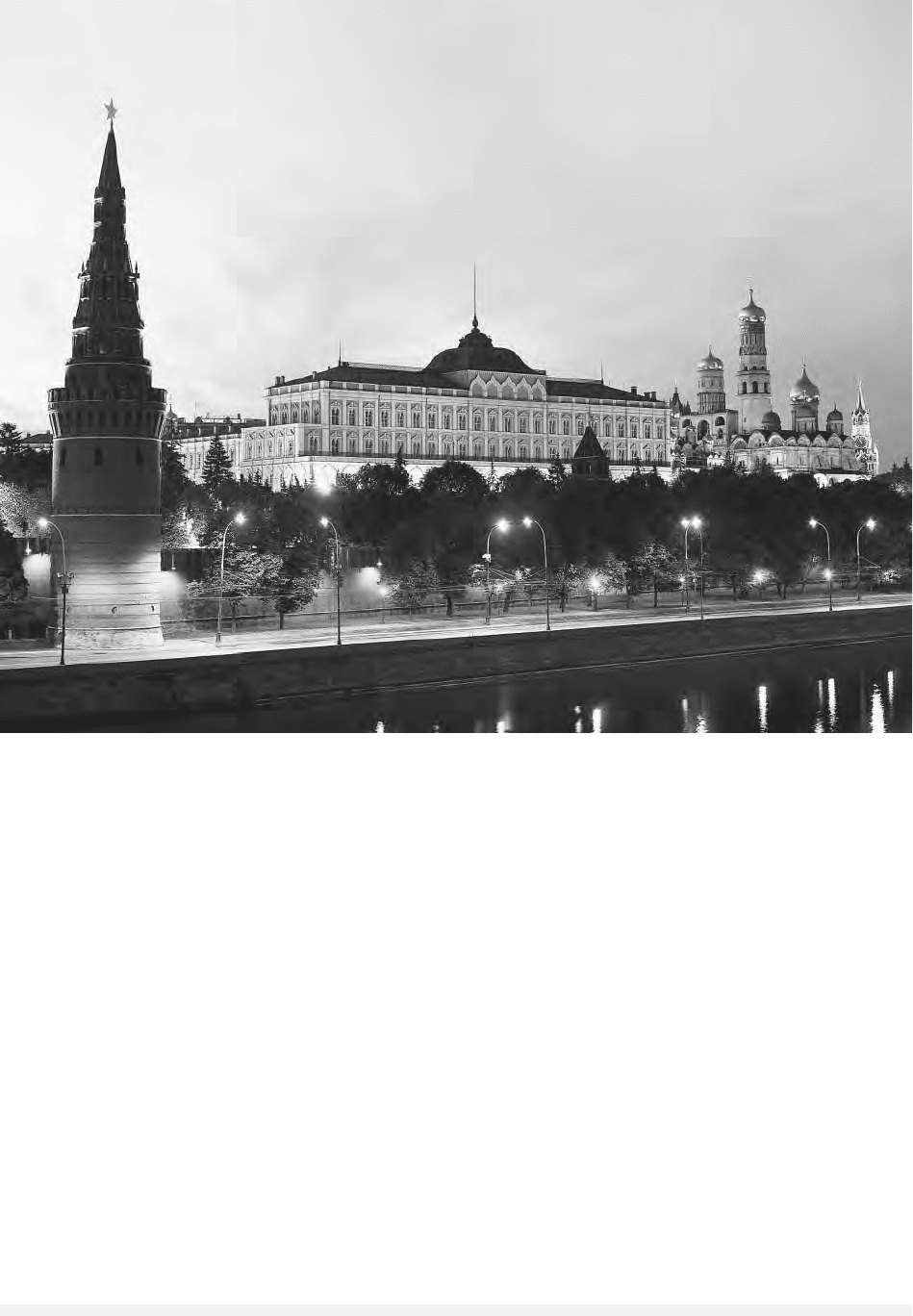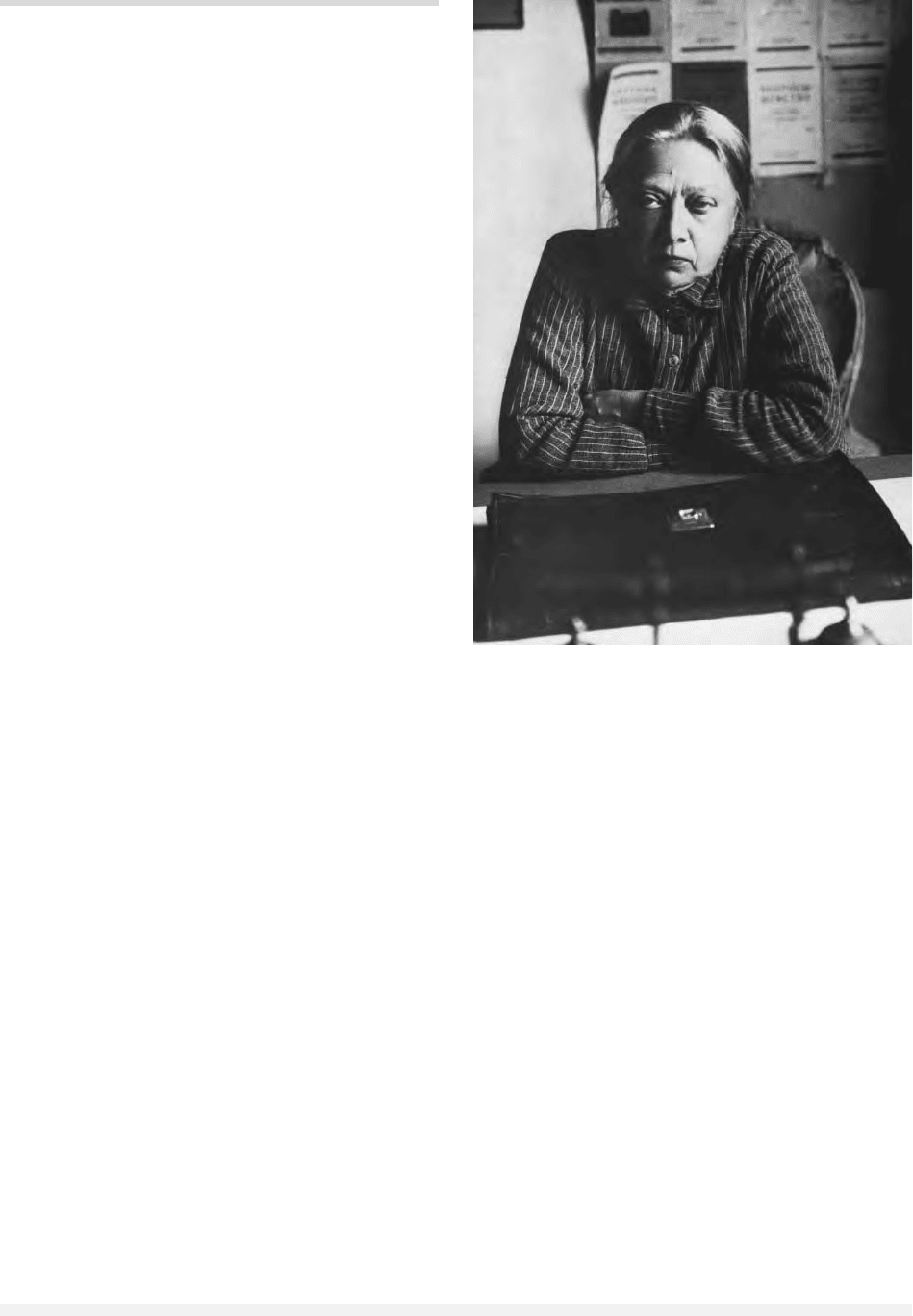Encyclopedia of Russian History
Подождите немного. Документ загружается.


turn in foreign policy, pursuing cooperation with
the United States on issues such as disarmament,
the Middle East, Yugoslavia, and trade and eco-
nomic relations. He was also viewed by many as
one of the most important voices for liberalism and
democracy in post-Communist Russia.
However, the incipient partnership between
Moscow and Washington began to flounder in
1993 over such issues as the war in Yugoslavia and
NATO (North Atlantic Treaty Organization) ex-
pansion. Critics began to push for a more forceful
and aggressive Russian foreign policy, and Kozyrev’s
language also became more bellicose on occasion,
including threats against Russia’s neighbors and an
assertion of special rights for Russia in the former
Soviet space—the Near Abroad. Nonetheless, this
was not enough, and by 1995 Yeltsin let it be
known that he was no longer satisfied with the
course of Russia’s foreign policy. In January 1996
Yevgeny Primakov, a career Soviet diplomat known
for more conservative views, replaced Kozyrev, who
then served as a member of the Russian Duma (par-
liament) until the end of 1999. He has written nu-
merous articles and books on international politics.
See also: NEAR ABROAD; PERESTROIKA; YELTSIN, BORIS
NIKOLAYEVICH
BIBLIOGRAPHY
Kozyrev, Andrei. (1995). “Partnership or Cold Peace?”
Foreign Policy 99: 3–14.
Talbott, Strobe. (2002). The Russia Hand: A Memoir of
Presidential Diplomacy. New York: Random House.
P
AUL
J. K
UBICEK
KRASNOV, PYOTR NIKOLAYEVICH
(1869–1947), Cossack ataman, anti-Bolshevik
leader, and author.
Son of a Cossack general, Pyotr Krasnov was
born in St. Petersburg and educated at Pavlovsk
Military School, graduating in 1888. During World
War I, he rose to the rank of lieutenant-general and
to the command of the Third Cavalry Corps in Au-
gust 1917. After the October Revolution, in uneasy
collaboration with Alexander Kerensky (whom, as
a monarchist, he despised), Krasnov was among the
first to take military action against the Bolsheviks,
attempting to lead Cossack forces from Gatchina
toward Petrograd. However, the Bolsheviks dis-
suaded his Cossacks from becoming involved in
“Russian affairs,” and Krasnov himself was taken
prisoner near Pulkovo. Remarkably, he was re-
leased after swearing not to oppose the Soviet gov-
ernment further. He immediately moved to the Don
territory, was elected ataman of the Don Cossack
Host in May 1918, and, assisted by Germany,
cleared the Don of Red forces over the summer of
that year. After the armistice, his former collabo-
ration with Germany made his position difficult.
Following defeats at the hands of the Reds and
quarrels with the pro-Allied General Denikin, in
early 1919 Krasnov resigned his post and emigrated
to Germany. He subsequently became a prolific
writer of forgettable historical novels but also
worked with various anti-Bolshevik groups in inter-
war Europe, eventually allying himself with the
Nazis and helping them, from 1941 to 1945, to
form anti-Soviet Cossack units from Soviet POWs.
In 1945 he joined the Cossack puppet state that the
Nazis established in the Italian Alps. Surrendering
to the British in May 1945, he was among those
forcibly repatriated to the Soviet Union, in accor-
dance with provisions of the Yalta agreement. In
January 1947, accused of treason, he was hanged,
by order of the Military Collegium of the USSR
Supreme Court.
See also: CIVIL WAR OF 1917–1922; COSSACKS; KERENSKY,
ALEXANDER FYODOROVICH
BIBLIOGRAPHY
Tolstoy, Nikolai. (1977). Victims of Yalta. London: Hod-
der & Stoughton.
J
ONATHAN
D. S
MELE
KRAVCHUK, LEONID MAKAROVICH
(b. 1934), Ukrainian politician and first president
of post-Soviet Ukraine.
Elected president of Ukraine on December 1,
1991—the same date as the historic referendum on
Ukrainian independence—Kravchuk won deci-
sively, garnering 61.6 percent of the popular vote
in a six-way contest. His primary political achieve-
ment was to establish Ukraine’s sovereignty and
maintain peace and social order with a minimum
of violence and almost no ethnic conflict. It is im-
possible to overemphasize the importance of this
accomplishment. However, he appears to have mis-
understood the relationship between state building
KRAVCHUK, LEONID MAKAROVICH
783
ENCYCLOPEDIA OF RUSSIAN HISTORY

and economic reforms. This failure would cost him
the presidency in early elections in July 1994.
A consummate politician, Kravchuk gained for
himself the nickname “sly fox” because of his abil-
ity to maneuver in predicaments that he himself
had created. His political shrewdness manifested it-
self in the events of 1991 when, as chairman of the
Ukrainian Supreme Soviet, he publicly vacillated
during the Moscow coup attempt of August 19–21.
While other Ukrainian officials supported Russian
President Boris Yeltsin, Kravchuk urged caution.
With the failure of the coup and with public
opinion turning against him, Kravchuk led the
Communist Party of Ukraine (CPU) to join the de-
mocratic opposition on August 24 and to adopt
Ukraine’s Declaration of Independence by a vote of
346 to 1. Kravchuk also redeemed himself by re-
signing from the CPU and the CPSU.
Clearly, the CPU strategy was to retain power
in an independent Ukraine. The democratic oppo-
sition was too weak and disorganized to take power
on its own; for this, they needed the Communists.
It is ironic that, as the former ideology chief of the
CPU, Kravchuk persecuted nationalist groups, such
as the Popular Front for Perestroika in Ukraine
(Rukh), only to appropriate their goals and program
in his 1991 bid for the newly established presi-
dency. As president, however, Kravchuk effectively
postponed economic and political reforms in favor
of nation building. A notable aspect of his leader-
ship was a continuing reliance on officials of the
former Communist apparat in key governmental
positions. Consequently, the simultaneous pursuit
of political stability and economic reform was all
but ruled out.
Confused and contradictory economic policies
emanated from Kravchuk’s government. He pub-
licly supported radical reforms even as he worked
to strengthen the hold of the former nomenklatura
over the state and economy. The saga of Kravchuk’s
management of the economy was the massive
emission of cheap credits and budget subsidies to
industry, coupled with the imposition of adminis-
trative controls over prices and currency exchange
rates. Major price increases in January and July
1992 drove Ukraine from the ruble zone in No-
vember of that year. But Ukrainian authorities
proved no better at controlling inflation, plunging
the nation into hyperinflation throughout 1993,
when prices increased by more than 10,000 per-
cent. Industrial output also plunged precipitously
as the economic crisis widened and deepened.
Throughout 1992 and into 1993, Kravchuk
was locked in a struggle with Prime Minister Leonid
D. Kuchma for authority to reform the economy.
Consequently, Kravchuk dismissed his errant pre-
mier in September 1993. The president made a half-
hearted attempt to renew the command economy
in late 1993, but by then the economic decline se-
verely damaged Kravchuk’s credibility. In response
to pressure from heavily industrialized eastern
Ukraine, Kravchuk agreed to early elections, to be
held in July 1994. Facing his one-time premier,
Leonid Kuchma, Kravchuk was defeated in the sec-
ond round, garnering but 45.1 percent of the pop-
ular vote. The former president did not retire from
politics, however; he was elected a member of par-
liament in a special election in September 1994, re-
placing a people’s deputy who died before taking
office. He was reelected in 1998 and 2002 from the
party lists of the Social Democratic Party of
Ukraine, and from 1998 onward has been a mem-
ber of the parliamentary Committee on Foreign Re-
lations.
See also: PERESTROIKA; UKRAINE AND UKRAINIANS
BIBLIOGRAPHY
Kravchuk, Robert S. (2002). Ukrainian Political Economy:
The First Ten Years. New York: Palgrave Macmillan.
Kuzio, Taras, and Andrew Wilson. (1994). Ukraine: Per-
estroika to Independence. Edmonton: Canadian Insti-
tute of Ukrainian Studies Press.
Wilson, Andrew. (1997). “Ukraine: Two Presidents and
Their Powers.” In Postcommunist Presidents, ed. Ray
Taras. New York: Cambridge University Press.
R
OBERT
S. K
RAVCHUK
KREMLIN
Few architectural forms have acquired greater res-
onance than the Moscow Kremlin. In actuality
many medieval Russian towns had a “kremlin,” or
fortified citadel, yet no other kremlin acquired the
fame of Moscow’s. The Kremlin structure, a potent
symbol of Russian power and inscrutability, owes
much of its appearance to the Russian imagina-
tion—especially the tower spires added in the sev-
enteenth century by local architects. Yet the main
towers and walls are the product of Italian fortifi-
cation engineering of the quattrocento, already
long outdated in Italy by the time of their con-
struction in Moscow. Nonetheless, the walls proved
KREMLIN
784
ENCYCLOPEDIA OF RUSSIAN HISTORY

adequate against Moscow’s traditional enemies
from the steppes, whose cavalry was capable of in-
flicting great damage on unwalled settlements, but
had little or no heavy siege equipment.
In the 1460s the Kremlin’s limestone walls, by
then almost a century old, had reached a danger-
ous state of disrepair. Local contractors were hired
for patchwork; as for reconstruction, Ivan III
turned to Italy for specialists in fortification. Be-
tween 1485 and 1516 the old fortress was replaced
with brick walls and towers extending 2,235 me-
ters and ranging in thickness from 3.5 to 6.5 me-
ters. The height of the walls varied from eight to
nineteen meters, with the distinctive Italian “swal-
lowtail” crenelation. Of the twenty towers, the
most elaborate were placed on the corners or at the
main entrances to the citadel. Among the most im-
posing is the Frolov (later Spassky, or Savior,
Tower), built between 1464 and 1466 by Vasily
Ermolin and rebuilt in 1491 by Pietro Antonio So-
lari, who arrived in Moscow from Milan in 1490.
The decorative crown was added in 1624 and 1625
by Bazhen Ogurtsov and the Englishman Christo-
pher Halloway. At the southeast corner of the
walls, the Beklemishev Tower (1487–1488, with an
octagonal spire from 1680) was constructed by
Marco Friazin, who frequently worked with Solari.
This and similar Kremlin towers suggest compar-
isons with the fortress at Milan. The distinctive
spires were added by local architects in the latter
part of the seventeenth century.
Although he built no cathedrals, Pietro Anto-
nio Solari played a major role in the renovation of
the Kremlin. He is known not only for his four
KREMLIN
785
ENCYCLOPEDIA OF RUSSIAN HISTORY
The Moscow Kremlin at twilight. © R
OYALTY
-F
REE
/CORBIS

entrance towers—the Borovitsky, the Constantine
and Helen, the Frolov, and the Nikolsky (all
1490–1493)—as well as the magnificent corner Ar-
senal Tower and the Kremlin wall facing the Red
Square, but also for his role in the completion of
the Faceted Chambers (Granovitaya palata), its
name due to the diamond-pointed rustication of its
limestone main facade. Used for banquets and state
receptions within the Kremlin palace complex, the
building was begun in 1487 by Marco Friazin, who
designed the three-storied structure with a great
hall whose vaulting was supported by a central
pier. Much of the ornamental detail, however, was
modified or effaced during a rebuilding of the
Chambers by Osip Startsev in 1682.
The rebuilding of the primary cathedral of
Moscow, the Dormition of the Virgin, began in the
early 1470s with the support of Grand Prince Ivan
III and Metropolitan Philip, leader of the Russian Or-
thodox Church. Local builders proved incapable of
so large and complex a task. Thus when a portion
of the walls collapsed, Ivan obtained the services of
an Italian architect and engineer, Aristotle Fiora-
vanti, who arrived in Moscow in 1475. He was in-
structed to model his structure on the Cathedral of
the Dormition in Vladimir; and while his design in-
corporates certain features of the Russo-Byzantine
style, the architect also introduced a number of tech-
nical innovations. The interior—with round columns
instead of massive piers—is lighter and more spa-
cious than any previous Muscovite church. The
same period also saw the construction of smaller
churches in traditional Russian styles, such as the
Church of the Deposition of the Robe (1484–1488)
and the Annunciation Cathedral (1484–1489).
The ensemble of Kremlin cathedrals commis-
sioned by Ivan III concludes with the Cathedral of
the Archangel Mikhail, built in 1505–1508 by Ale-
viz Novy. The building displays the most extrava-
gantly Italianate features of the Kremlin’s Italian
Period, such as the scallop motif, a Venetian fea-
ture soon to enter the repertoire of Moscovy’s ar-
chitects. The wall paintings on the interior date
from the mid-seventeenth century and contain, in
addition to religious subjects, the portraits of Russ-
ian rulers, including those buried in the cathedral
from the sixteenth to the end of the seventeenth
centuries.
The culminating monument in the rebuilding
of the Kremlin is the Bell Tower of Ivan the Great,
begun in 1505, like the Archangel Cathedral, and
completed in 1508. Virtually nothing is known of
its architect, Bon Friazin, who had no other recorded
structure in Moscow. Yet he was clearly a brilliant
engineer, for his bell tower—60 meters high, in two
tiers—withstood the fires and other disasters that
periodically devastated much of the Kremlin. The
tower, whose height was increased by an additional
21 meters during the reign of Boris Godunov, rests
on solid brick walls that are 5 meters thick at the
base and 2.5 meters on the second tier.
The most significant seventeenth-century ad-
dition to the Kremlin was the Church of the Twelve
Apostles, commissioned by Patriarch Nikon as part
of the Patriarchal Palace in the Kremlin. This large
church was originally dedicated to the Apostle
Philip, in implicit homage to the Metropolitan
Philip, who had achieved martyrdom for his op-
position to the terror of Ivan IV.
During the first part of the eighteenth century,
Russia’s rulers were preoccupied with the building
of St. Petersburg. But in the reign of Catherine the
Great, the Kremlin once again became the object of
autocratic attention. Although little came of
Catherine’s desire to rebuild the Kremlin in a neo-
classical style, she commissioned Matvei Kazakov
to design one of the most important state build-
ings of her reign: the Senate, or high court, in the
Kremlin. To create a triangular four-storied build-
ing, Kazakov masterfully exploited a large but
awkward lot wedged in the northeast corner of the
Kremlin. The great rotunda in its center provided
the main assembly space for the deliberations of the
Senate. To this day the rotunda is visible over the
center of the east Kremlin wall.
During the nineteenth century, Nicholas I ini-
tiated the rebuilding of the Great Kremlin Palace
(1839–1849), which had been severely damaged in
the 1812 occupation. In his design the architect
Konstantin Ton created an imposing facade for the
Kremlin above the Moscow River and provided a
stylistic link with the Terem Palace, the Faceted
Chambers, and the Annunciation Cathedral within
the Kremlin. Ton also designed the adjacent build-
ing of the Armory (1844–1851), whose historicist
style reflected its function as a museum for some
of Russia’s most sacred historical relics.
With the transfer of the Soviet capital to
Moscow in 1918, the Kremlin once again became
the seat of power in Russia. That proved a mixed
blessing, however, as some of its venerable monu-
ments, such as the Church of the Savior in the
Woods, the Ascension Convent, and the Chudov
Monastery, were destroyed in order to clear space
for government buildings. Only after the death of
KREMLIN
786
ENCYCLOPEDIA OF RUSSIAN HISTORY

Josef Stalin was the Kremlin opened once again to
tourists. The most noticeable Soviet addition to the
ensemble was the Kremlin Palace of Congresses
(1959–1961, designed by Mikhail Posokhin and
others). It has the appearance of a modern concert
hall (one of its uses), whose marble-clad rectangu-
lar outline is marked by narrow pylons and multi-
storied shafts of plate glass. The one virtue of its
bland appearance is the lack of conflict with the
historic buildings of the Kremlin, which remain the
most important cultural shrine in Russia.
See also: ARCHITECTURE; ARMORY; CATHEDRAL OF THE
ARCHANGEL; CATHEDRAL OF THE DORMITION;
MOSCOW; RED SQUARE
BIBLIOGRAPHY
Brumfield, William Craft. (1993). A History of Russian
Architecture. New York: Cambridge University Press.
Hamilton, George Heard. (1983). The Art and Architecture
of Russia. New York: Penguin Books.
W
ILLIAM
C
RAFT
B
RUMFIELD
KREMLINOLOGY
Close analysis of the tense power struggles among
the Soviet leadership. A term coined during the last
days of the Stalin regime with the onset of the Cold
War.
Usually more than just a study of contending
personalities, or a “who-whom” (who is doing
what to whom), Kremlinology was an indispens-
able analysis of Soviet policy alternatives and their
implications for the West. It also turned out to be
a point of departure for any serious political his-
tory, inevitably connected to the ideas that drove
the Soviet regime and in the end determined its fate.
Western intelligence experts, academics, and jour-
nalists all made contributions to this pursuit. At-
tention was often focused on “protocol evidence,”
such as the order in which leaders’ names might
appear on various official lists, or the way they
were grouped around the leader in photographs.
However, since factional rivalry was usually ex-
pressed in ideological pronouncements and debates,
the most widely respected practitioners of Kremli-
nology were emigré writers who had direct expe-
rience of the ways of the Soviet communists. The
most famous of these was the Menshevik Boris
Nikolayevsky. Initially Kremlinologists centered on
quarrels among Josef Stalin’s subordinates in or-
der to get an idea of his policy alternatives and
turns. After Stalin’s death, Kremlinology mapped
out the succession struggle that occasioned the rise
of Nikita Khrushchev. It was again useful in un-
derstanding the politics of the Gorbachev reform
era and the destruction of Soviet power.
The domestic and foreign policy issues were de-
bated in the ideological language of the first great
Soviet succession struggle in the 1920s that brought
Stalin from obscurity to supreme power. After his
defeat and exile, Leon Trotsky explained Stalin’s rise
to the Western public as the victory of a narrow
insular national Communism, according to the slo-
gan “socialism in one country,” over his own in-
ternationalist idea of “permanent revolution.”
Materials from three Trotsky archives in the West
later showed these extreme positions to have been
less crucial to Stalin’s ascent than his complex ma-
neuvers for a centrist position between right and
left factions. Trotsky continued to analyze Soviet
politics during the Great Purge of 1936–1938 in his
Byulleten oppozitsy (Bulletin of the Opposition). This
was matched by the commentary of the well-con-
nected Moscow correspondents of the Menshevik
Sotsialistichesky vestnik (Socialist Courier).
For various reasons, the émigré writings had to
be read with caution. Often they were employed to
establish a position in the debate over the Russian
Question: What is the nature of the Soviet regime,
and has it betrayed the revolution? In 1936 Niko-
layevsky published the Letter of an Old Bolshevik,
presumably the confessions of Nikolai Bukharin in-
terviewed in Paris. It contained important informa-
tion indicating the origins of Stalin’s purges in a
1932 dispute over the anti-Stalin platform document
of Mikhail Ryutin. However, the Letter was drama-
tized and embellished by Nikolayevsky’s gleanings
from other sources. Some historians later rejected it
as spurious and even denied the existence of a Ryutin
Program. But during Mikhail Gorbachev’s glasnost
campaign the full text was published, reading quite
as Nikolayevsky had described it.
In Stalin’s last days, Nikolayevsky tried to in-
terpret the antagonism between Leningrad chief An-
drei Zhdanov and Stalin’s protégé Georgy Malenkov
by linking Zhdanov to Tito and the Yugoslav Com-
munists and Malenkov to Mao and the Chinese.
Later studies bore this out. The rise of Khrushchev
as successor to Stalin was charted by Boris Meiss-
ner, Myron Rush, Wolfgang Leonhard, and Robert
Conquest. Michel Tatu described Khrushchev’s fall
in 1964 and the central role played by Mikhail
Suslov, the ideological secretary.
KREMLINOLOGY
787
ENCYCLOPEDIA OF RUSSIAN HISTORY

Suslov loomed large in Soviet politics from this
point until his death at the end of the Brezhnev
regime in 1982. The ideological post was the cen-
ter of gravity for a regime of collective leadership
under the rubric of “stabilization of cadres.” That
Suslov died a few months before Brezhnev in 1982
meant he could not oversee the succession in the
interests of the Kremlin gerontocracy. The result
was a thorough housecleaning by Yuri Andropov
in his brief tenure. An even more thorough shakeup
by Mikhail Gorbachev followed. This would have
been unlikely had Suslov lived.
In defense of the Suslov pattern of collective
leadership, the Politburo tried its best to shore up
Yegor Ligachev in the ideological post as a limit on
Gorbachev. But Gorbachev managed to destroy all
the party’s fetters on his power by 1989, just as
he lost the East European bloc. After that, he be-
haved like a conscious student of Soviet succession
and proclaimed himself a centrist, balancing be-
tween the radical Boris Yeltsin and the weakened
consolidation faction of the Communist Party of
the Soviet Union (CPSU). The last stand of the lat-
ter was the attempted putsch of August 1991, the
failure of which left Gorbachev alone with a venge-
ful Yeltsin.
Commentary on the Yeltsin leadership of post-
Soviet Russia echoed some themes of Kremlinology,
especially in analysis of the power of the Yeltsin
group (“The Family”) and its relation to well-heeled
post-Soviet tycoons (“The Oligarchs”). However,
power in the Kremlin could no longer be read in
Communist ideological language and had to be
studied as with any other state. Kremlinology, or
analysis of Soviet power struggles, nevertheless re-
tains its value for political historians who can take
note of a recurrent programmatic alternance be-
tween a leftist Leningrad tendency and a rightist
Moscow line. The centrist who defeated the others
by timely turns was able to triumph in the three
great Soviet succession struggles.
See also: HISTORIOGRAPHY; STALIN, JOSEF VISSARI-
ONOVICH; SUSLOV, MIKHAIL ANDREYEVICH; UNITED
STATES, RELATIONS WITH
BIBLIOGRAPHY
Conquest, Robert. (1961). Power and Policy in the USSR.
New York: Macmillan.
D’Agostino, Anthony. (1998). Gorbachev’s Revolution,
1985–1991. Basingstoke, UK: Macmillan.
Gelman, Harry. (1984). The Brezhnev Politburo and the De-
cline of Détente. Ithaca, NY: Cornell University Press.
Leonhard, Wolfgang. (1962). The Kremlin Since Stalin, tr.
Elizabeth Wiskemann. New York: Praeger.
Linden, Carl A. (1966). Khrushchev and the Soviet Leader-
ship, 1957–1964. Baltimore: Johns Hopkins.
Nicolaevsky, Boris. (1965). Power and the Soviet Elite. New
York: Praeger..
Rush, Myron. (1974). How Communist States Change Their
Rulers. Ithaca, NY: Cornell University Press.
A
NTHONY
D’A
GOSTINO
KRITZMAN, LEV NATANOVICH
(1890–c. 1937), Soviet economist and agrarian ex-
pert.
Born in 1890, Kritzman became a Menshevik in
1905. After a long period in exile, he returned to
Russia in early 1918 when he joined the Bolshevik
Party. An expert in economic policy and a strong
advocate of planning, he held various posts in the
Supreme Council for the National Economy and in
1921 joined the Presidium of Gosplan (State Plan-
ning Agency).
In addition to his professional duties, he pub-
lished numerous works on planning and the econ-
omy in which he argued for introducing a single
economic plan. He was criticized by Lenin for this
position. After the introduction of the New Eco-
nomic Policy in 1921, Kritzman, together with Ya.
Larin, Leon Trotsky, and Yevgeny Preobrazhensky,
continued to advocate an extension of state plan-
ning. During the 1920s, Kritzman produced a num-
ber of important works, including a major study of
war communism, Geroichesky period velikoi russkoi
revolyutsy (The Heroic Period of the Great Russian Rev-
olution), still one of the key analyses of economic
policy in the early Soviet period. As director of the
Agrarian Institute of the Communist Academy
from 1925 and editor of its journal Na Agrarnom
Fronte (On the Agricultural Front), he promoted em-
pirical research into class differentiation among the
peasantry and called for greater state support for
socialized agriculture. He also served during his ca-
reer as assistant director of the Central Statistical
Administration and a member of the editorial boards
of Pravda, Problemy Ekonomiki (Problems of Econom-
ics) and the Great Soviet Encyclopedia. Stalin’s launch
of mass collectivisation and dekulakization in late
1929 rendered Kritzman’s work and ideas obsolete
by eradicating the individual household farm. After
KRITZMAN, LEV NATANOVICH
788
ENCYCLOPEDIA OF RUSSIAN HISTORY

some years conducting private research, he was ar-
rested and died in prison either in 1937 or 1938.
See also: COLLECTIVIZATION OF AGRICULTURE; NEW ECO-
NOMIC POLICY; PEASANT ECONOMY; WAR COMMU-
NISM
BIBLIOGRAPHY
Cox, Terry. (1986). Peasants, Class and Capitalism. The
Rural Research of L.N. Kritzman and his School. Ox-
ford: Clarendon Press.
Solomon, Susan Gross. (1977). The Soviet Agrarian De-
bate: A Controversy in Social Science 1923–1929. Boul-
der, CO: Westview Press.
N
ICK
B
ARON
KRONSTADT UPRISING
The Kronstadt Uprising was a well-known revolt
against the Communist government from March 1
to 18, 1921, at Kronstadt, a naval base in the Gulf
of Finland, base of the Russian Baltic Fleet, and a
stronghold of radical support for the Petrograd So-
viet in 1917.
By early 1921 the Bolshevik government had
defeated the armies of its White opponents, but had
also presided over a collapse of the economy and
was threatened by expanding Green rebellions in
the countryside. The Kronstadt garrison was disil-
lusioned by reports from home of the depredations
of the food requisitioning detachments, and by the
corruption and malfeasance of Communist leaders.
In response to strikes and demonstrations in Pet-
rograd in February 1921, a five-man revolution-
ary committee took control of Kronstadt. It purged
local administration, reorganized the trade unions,
and prepared for new elections to the soviet, while
preparing for a Communist assault. It called for an
end to the Communist Party’s privileges; for new,
free elections to soviets; and an for end to forced
grain requisitions in the countryside.
Communist reaction was quick. A first attack
on March 8 resulted only in bloodshed; however,
on March 18 a massive assault across the ice by
50,000 troops, stiffened by Communist detach-
ments and several hundred delegates to the Tenth
Party Congress and led by civil war hero Mikhail
Tukhachevsky, captured the island stronghold.
Thousands of Kronstadt activists died in the assault
or in the repression that followed.
The Kronstadt rebellion, along with the Green
Movement, presented a direct threat to Communist
control. While the rebellions were put down, their
threat led to important policy changes at the Tenth
Party Congress, including the abandonment of War
Communism (the grain monopoly and forced grain
requisitions) and a ban on factions within the Com-
munist Party.
See also: CIVIL WAR OF 1917–1922; GREEN MOVEMENT;
SOCIALIST REVOLUTIONARIES
BIBLIOGRAPHY
Avrich, Paul. (1970). Kronstadt 1921. Princeton, NJ:
Princeton University Press.
Getzler, Israel. (1983). Kronstadt, 1917–1921: The Fate of
a Soviet Democracy. Cambridge, UK: Cambridge Uni-
versity Press.
A. D
ELANO
D
U
G
ARM
KROPOTKIN, PYOTR ALEXEYEVICH
(1842–1921), Russian revolutionary.
Born into a family of the highest nobility,
Kropotkin (the “Anarchist Prince,” according to his
1950 biographer George Woodcock) swam against
the current of convention all his life. He received his
formal education at home and then at the Corps
of Pages in St. Petersburg, graduated in 1862, and,
to the tsar’s astonishment, requested a posting to
Siberia rather than the expected court career. There
he remained until 1867. Siberia was a liberation for
Kropotkin, contrary to the experience of others. He
participated as a geographer and naturalist in expe-
ditions organized by the Imperial Russian Geograph-
ical Society (IRGS). He was also entering his parallel
career as a revolutionary: for him, Russia’s Age of
Great Reforms was that of the discovery of un-
changing corruption among Siberian state officials.
In 1867 Kropotkin returned to St. Petersburg
where he enrolled at the University (he never grad-
uated), supporting himself by working for the
IRGS. His scientific reputation grew and in 1871 he
was offered the post of IRGS secretary, which he
rejected. Events in his own life (the death of his
tyrannical father), in Russia (the growth of a rev-
olutionary student movement), and in the world
(the Paris Commune) strengthened his revolution-
ary feelings. In 1872 he visited Switzerland for the
KROPOTKIN, PYOTR ALEXEYEVICH
789
ENCYCLOPEDIA OF RUSSIAN HISTORY

first time to discover more about the International
Workingmen’s Association and on his return to
Russia began to frequent the Chaikovsky Circle.
As his 1976 biographer Martin Miller revealed,
Kropotkin authored the Circle’s principal pamphlet,
“Must We Examine the Ideal of the Future Order?”
(1873).
Kropotkin was by this time (though the title
was yet to be invented) an anarchist-communist—
that is, he advocated the destruction of state
tyranny over society (as anarchist predecessors like
William Godwin, Pierre Proudhon, and Mikhail
Bakunin had done) on one hand, while on the other
he sought a communist, egalitarian transformation
of society (like Karl Marx, only without using the
authority of the state). This paradox required the
dissolution of national government and its post-
revolutionary replacement by a free federation of
small communes, a local government freely ad-
ministered from below rather than national and
imposed from above. Revolutionaries from privi-
leged backgrounds must organize the preceding
popular revolt by propaganda and persuasion only:
Workers and peasants must make the revolution
themselves.
In March 1874 Kropotkin was arrested for his
revolutionary activities and interrogated over a
two-year period. Moved to a military hospital, he
was liberated in a complex, sensational escape or-
ganized by his comrades. Kropotkin continued his
revolutionary career in the Jura Federation, Switzer-
land, comprising the anarchist sections of the In-
ternational, and from early 1877 began for the first
time to take part in public political life: demon-
strating, making speeches, attending congresses,
writing articles. This activity is chronicled in detail
in Caroline Cahm’s 1983 biography. Around 1880,
the issue of terrorism or “propaganda by the deed,”
as was the expression of the time, arose. This was
crystalized by the assassination of Alexander II in
1881. Although not approving assassination as a
political method, Kropotkin was unwilling to con-
demn the assassins, explaining their actions as the
result of impotent desperation. At the end of 1882
he was arrested in France for revolutionary activ-
ity in which, for once, he had not participated. Sen-
tenced to five years’ imprisonment, he was released
following international pressure in early 1886 and
settled in London, England.
For a living and for the cause, Kropotkin now
lectured throughout Britain and wrote for numer-
ous publications. His principal fame during the
British period derived from his books, including In
Russian and French Prisons (1887), Memoirs of a Rev-
olutionist (1899), Fields, Factories, and Workshops
(1899), Mutual Aid (1902), Modern Science and Anar-
chism (1903), Russian Literature (1905), The Terror in
Russia (1909), and The Great French Revolution (1909).
With British comrades, he launched the anarchist
journal Freedom. He wrote frequently for political
publications in several languages. He was greatly en-
couraged by the 1905 revolution in Russia.
Kropotkin’s writings during these years of ex-
ile are parts of an ongoing argument with those
hegemonic Victorian thinkers Thomas Malthus,
Herbert Spencer, and Charles Darwin. He takes is-
sue with Malthus’s bleak vision to argue that hu-
manity’s future is not limited by its reproductive
success, but by science and equality. Nature shows
the role of mutual aid in its evolution, analogous
to the freely cooperating communes of postrevolu-
tionary humanity. Anarchist communism is not
merely desirable, but inevitable. Kropotkin’s opti-
mistic view of science no longer commands respect,
but to many his works beckon us to a wonderful
future.
In 1917, in old age, Kropotkin was able to re-
turn to revolutionary Russia. He worked for a
while on various federalist projects and died in
Dmitrov, a Moscow province. His last major work,
Ethics, was published posthumously and incom-
plete in 1924.
See also: ANARCHISM; BAKUNIN, MIKHAIL ALEXAN-
DROVICH; IMPERIAL RUSSIAN GEOGRAPHICAL SOCIETY
BIBLIOGRAPHY
Cahm, Caroline. (1989). Kropotkin and the Rise of Revolu-
tionary Anarchism 1872–1886. Cambridge, UK: Cam-
bridge University Press.
Cahm, Caroline, Colin Ward, and Ian Cook. (1992). P. A.
Kropotkin’s Sesquicentennial: A Reassessment and Trib-
ute. Durham: University of Durham, Centre for Eu-
ropean Studies.
Miller, Martin A. (1976). Kropotkin. Chicago: University
of Chicago Press.
Slatter, John (ed.). (1984). From the Other Shore: Russian
Political Emigrants in Britain 1880–1917. London:
Frank Cass.
Woodcock, George, and Ivan Avakumovic. (1950). The
Anarchist Prince: A Biographical Study of Peter
Kropotkin. London: Boardman.
J
OHN
S
LATTER
KROPOTKIN, PYOTR ALEXEYEVICH
790
ENCYCLOPEDIA OF RUSSIAN HISTORY

KRUPSKAYA, NADEZHDA
KONSTANTINOVNA
(1869–1939), revolutionary, educator, head of
Glavpolitprosvet (the Chief Committee for Political
Education) and deputy head of the Commissariat
of Enlightenment, full member of the Central Com-
mittee of the Communist Party (1927–1939), wife
of Vladimir Ilich Lenin.
A native of St. Petersburg, Nadezhda Krup-
skaya developed an early and lifelong interest in ed-
ucation, especially that of adults. Beginning in the
1890s, she taught in workers’ evening and adult
education schools. In Marxist circles she met
Vladimir Ilich Ulyanov (Lenin). When she and
Lenin were both arrested in 1895 and 1896, she
followed him to Siberia as his fiancée and later as
his wife. While in exile, Krupskaya wrote her most
famous work, The Woman Worker (first published
in 1901 and 1905). Here she explored the problems
faced by women as workers and mothers.
From 1901 to 1917 Krupskaya shared Lenin’s
life in exile abroad, helping to direct his correspon-
dence and build up the organization of the Party.
She worked on the editorial boards of the journals
Rabotnitsa, Iskra, Proletary, and Sotsial-Demokrat.
She also began writing about theories of progres-
sive American and European education, especially
those of John Dewey. In the 1920s these ideas on
education were to have some impact on Soviet
schooling, though they were then reversed in the
1930s.
After 1917 she headed the newly created Ex-
tra-Curricular Department of the Commissariat of
Education, which was later replaced by the Chief
Committee on Political Education (Glavpolitprosvet).
She also worked in the zhenotdel (the women’s sec-
tion of the Party), editing the journal Kommunistka,
but never heading the section.
In 1922 and 1923, when Lenin was seriously
incapacitated with illness, Krupskaya quarreled
badly with Josef Stalin, whom she found rude and
boorish. When Lenin died in January 1924, Krup-
skaya found herself isolated and increasingly
drawn to side with the Leningrad Opposition led
by Grigory Zinoviev and Lev Kamenev. By the fall
of 1926, however, she had defected from the Op-
position. From 1927 to 1939 she served as a full
member of the (now much weakened) Central
Committee of the Party. During the height of the
Purges, she tried to save some of Stalin’s victims,
including Yuri Pyatakov, but without success.
Although Stalin gave a eulogy at her funeral in
1939, her works were suppressed until Nikita
Khrushchev’s Thaw.
Historians have tended to minimize Krupskaya’s
importance, viewing her primarily as Lenin’s wife.
Yet she played a crucial role in establishing the
Party, building up the political education appara-
tus that reached millions of people, and keeping
women’s issues on the political agenda.
See also: ARMAND, INESSA; EDUCATION; LENIN, VLADIMIR
ILICH; ZHENOTDEL
BIBLIOGRAPHY
McNeal, Robert H. (1972). Bride of the Revolution. Ann
Arbor: University of Michigan Press.
Noonan, Norma C. (1991). “Two Solutions to the Zhen-
skii Vopros in Russia and the USSR, Kollontai and
KRUPSKAYA, NADEZHDA KONSTANTINOVNA
791
ENCYCLOPEDIA OF RUSSIAN HISTORY
Nadezhda Krupskaya, wife of Vladimir Lenin, seated at her
desk. © H
ULTON
-D
EUTSCH
C
OLLECTION
/CORBIS

Krupskaia: A Comparison.” Women and Politics
2(3):77–100.
Stites, Richard. (1975). “Kollontai, Inessa, and Krupskaia:
A Review of Recent Literature.” Canadian-American
Slavic Studies 9(1):84–92.
Stites, Richard. (1978). The Women’s Liberation Movement in
Russia: Feminism, Nihilism, and Bolshevism, 1860–1930.
Princeton, NJ: Princeton University Press.
Wood, Elizabeth A. (1997). The Baba and the Comrade:
Gender and Politics in Revolutionary Russia. Bloom-
ington: Indiana University Press.
E
LIZABETH
A. W
OOD
KRYLOV, IVAN ANDREYEVICH
(1769–1844), writer, especially of satirical fables,
who is often called the “Russian Aesop.”
The son of a provincial army captain who died
when he was ten, Krylov had little formal educa-
tion but significant artistic ambitions. Entering the
civil service in Tver, Krylov was subsequently
transferred to the imperial capital of St. Petersburg
in 1782, which gave him access to the most promi-
nent of cultural circles. Although he began his lit-
erary career penning comic operas, when he joined
Nikolai Novikov and Alexander Radishchev on the
editorial board of the satirical journal Pochta dukhov
(Mail for Spirits) in 1789, he became recognized as
a leading figure in Russia’s Enlightenment. When
the French Revolution made enlightened principles
particularly dangerous during the last years of the
reign of Catherine the Great, Krylov left St. Peters-
burg to escape the more severe fates suffered by his
coeditors. He spent five years traveling and work-
ing in undistinguished positions.
In 1901, with the assumption of the throne by
Catherine’s liberally minded grandson, Alexander I,
Krylov moved to Moscow and resumed his literary
career. Five years later, he returned to St. Petersburg,
returning also to satire. He began translating the
works of French storyteller Jean La Fontaine, and
in the process discovered his own talents as a fab-
ulist. Moreover, his originality coincided with the
intellectual movement to create a national litera-
ture for Russia. His new circle was as illustrious as
the old, including the poet Alexander Pushkin, who
was the guiding spirit behind the evolution of Russ-
ian into a literary language.
Krylov’s fables, which numbered more than
two hundred, featured anthropomorphized animals
who made political statements about contempo-
rary Russian politics. This satirical style allowed
him to describe repressive aspects of the autocracy
without suffering the wrath of Catherine’s heirs.
He received government sinecure with a position in
the national public library, where he worked for
thirty years. Many of his characters and aphorisms
continue to resonate in Russian popular culture.
See also: CATHERINE II; ENLIGHTENMENT, IMPACT OF;
PUSHKIN, ALEXANDER SERGEYEVICH
BIBLIOGRAPHY
Krylov, Ivan. (1977). Krylov’s Fables, tr. with a preface
by Sir Bernard Pares. Westport, CT: Hyperion Press.
Stepanov, N. L. (1973). Ivan Krylov. New York: Twayne.
L
OUISE
M
C
R
EYNOLDS
KRYUCHKOV, VLADIMIR
ALEXANDROVICH
(b. 1924), Soviet police official; head of the KGB
from 1988 to 1991.
Born in Volgograd, Russia, Vladimir Kryuchkov
joined the Communist Party in 1944 and became a
full-time employee of the Communist Youth League
(Komsomol). In 1946 Kryuchkov embarked on a
legal career, working as an investigator for the
prosecutor’s office and studying at the All-Union
Juridical Correspondence Institute, from which he
received a diploma in 1949. Kryuchkov joined the
Soviet Ministry of Foreign Affairs in 1951 and en-
rolled as a student at the Higher Diplomatic School
in Moscow. He received his first assignment abroad
in 1955, when he was sent to Hungary to serve un-
der Soviet Ambassador Yuri Andropov. Kryuchkov
was in Budapest during the Soviet invasion in 1956
and was an eyewitness to the brutal suppression of
Hungarian nationalists by Soviet troops. After re-
turning to Moscow in 1959, he worked in the Cen-
tral Committee Department for Liaison with
Socialist Countries, which his former supervisor
Andropov now headed. In 1967, when Andropov
was appointed to the leadership of the KGB, the So-
viet police and intelligence apparatus, he brought
Kryuchkov, who rose to the post of chief of the
KGB’s First Chief Directorate (foreign intelligence) in
1977. In 1988 Soviet party leader Mikhail Gor-
bachev appointed Kryuchkov chairman of the KGB.
Although Kryuchkov voiced public support for
Gorbachev’s liberal reforms, he grew increasingly
KRYLOV, IVAN ANDREYEVICH
792
ENCYCLOPEDIA OF RUSSIAN HISTORY
